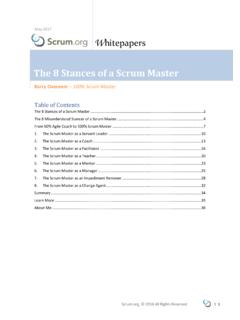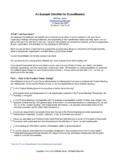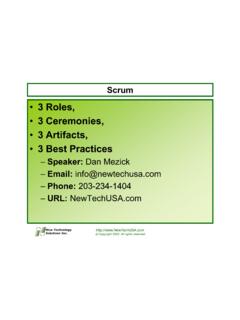Transcription of distributed scrum primer 1.0 - GoodAgile
1 THE distributed scrum primer Version Pete Deemer Author Narinder Kumar Vikas Hazrati Gabrielle Benefield Robert Benefield Contributors GoodAgile > Certified scrum Training for India and the World Important Note A thorough understanding of the principles and practices of scrum is recommended prior reading this guide. We recommend The scrum primer , available for free at , and The scrum Guide, available for free at About the Author Pete Deemer trains and coaches companies doing distributed agile development in India and elsewhere in Asia.
2 Pete is the founder of GoodAgile ( ) and co-founder of The scrum Training Institute ( ). He is a scrum Alliance Certified scrum Trainer, and the co-author of The scrum primer , a widely read introduction to scrum . Pete has spent the last 22 years leading teams building products and services at global companies, and as Yahoo! s VP of Product Development he led the company s large-scale adoption of scrum . In addition to his corporate work, Pete is a visiting lecturer at the National University of Singapore s Institute of Systems Science.
3 About the Contributors Narinder Kumar and Vikas Hazrati are the Delhi-based co-founders of Inphina Technologies ( ), which provides agile software development services to clients in Europe and the US. Gabrielle Benefield is a scrum Alliance Certified scrum Trainer, and she is the founder of London-based Agile Lean Training ( ). She and Robert Benefield provide agile and Lean training and consulting in Western and Eastern Europe, the US, and the Middle East. This work is licensed under a Creative Commons Attribution-NoDerivs Unported License.
4 INTRODUCTION Attracted by significantly lower costs in places like India, China, and Eastern Europe, many companies have embarked on globally distributed software development initiatives. Unfortunately, many have found that while per-hour development costs are indeed lower, overall project costs can be higher, after factoring in the significant challenges of communication and coordination, the cost of difficulties and delays, and higher project failure rates. Not surprisingly, many organizations have turned to scrum in hopes that it will enable their distributed teams to achieve significantly better results.
5 This primer outlines practices that can help distributed scrum Teams excel, and highlights some of the common pitfalls that teams encounter, along with ways to respond to these challenges. The most important point to start with is that the principles and practices of scrum in a distributed project are no different from the principles and practices of scrum in a single-location project: It s simply scrum , but with added challenges brought on by the distances and differences between locations. The scrum practices enable teams to deliver customer value early and often, add transparency, surface dysfunction, and drive continuous improvement through a simple framework of inspect and adapt all of which are even more more acutely needed in a distributed project, but at the same time are logistically more difficult to conduct.
6 The following pages outline practices which can help overcome these challenges, first in enabling communication and then in building trust. Then, useful tips for implementing the scrum roles, meetings, artifacts, and technical practices are outlined, as well as common pitfalls to be avoided. In the final analysis, there is no one right way to do distributed development using scrum , other than for teams to start with the principles and standard practices of scrum , and inspect and adapt to a solution that is well suited to their particular situation but this primer provides starting points and ideas that may help speed teams along the path of improvement.
7 ENABLING COMMUNICATION While there are technical issues that need to be considered when using scrum in a distributed environment, the biggest challenges center around human issues, starting with communication. At its most basic level, software development is both enabled by, and constrained by, the quality of the communication that takes place among the people involved. Customers form ideas about what they need, and communicate them to the development team; the team-members communicate with each other and with the customer to build functionality that satisfies those needs; the customer communicates feedback to the team about what s been built; and throughout this process, everyone communicates with each other about questions they have, obstacles they encounter, opportunities they see, and how they are feeling (satisfied, concerned, etc.)
8 Consider a Product Owner in one location and a development team in another location. The quality of the communication between them will directly determine how much business value (in the form of useful, high-quality software) is delivered. Every misunderstanding between the Product Owner and team means a little less value will be delivered; when the team implements a piece of functionality incorrectly, and has to go back and redo it, there is other work that in the end will not be completed. Also, the more effort the communication requires, the less business value will be produced; if the team has to leave 3 voicemails for the Product Owner to get a response to their question, the Product Owner will inevitably get a little less software in the end; the team was spending their time dialing and waiting, not coding!
9 Great software is typically produced only when there is great communication between the people involved, and poor communication will limit the quantity, quality, and correctness of the end result. So how do we ensure that communication between the Product Owner and team is as effective as possible? First, there are practical considerations. The various modes of communication email, telephone, face-to-face conversation can be placed on a richness scale, which looks something like this: Richer Communication Face-to-face conversation with a physical whiteboard High-resolution, large-screen videoconference with a virtual whiteboard High-resolution, large-screen videoconference Low-resolution, small-screen videoconference Telephone call using high quality phone hardware and a land line (=clear connection) Telephone call using poor quality phone hardware and VOIP (=noisy connection)
10 Instant messaging and real-time text chat Wikis and electronic discussion boards Email Poorer Communication By and large, the higher up this scale you are, the richer and easier the communication, the more natural the interaction and the more immediate and faithful the understanding between people. Email is, unfortunately, the go-to mode of communication between most distributed Product Owners and teams, and this is a mixed blessing. Its great strength is that it is not dependent on both parties being present simultaneously, and it preserves a record of the discussion that can be referenced later.












